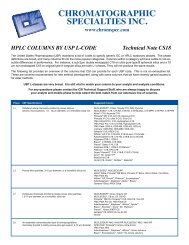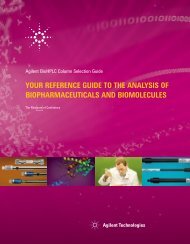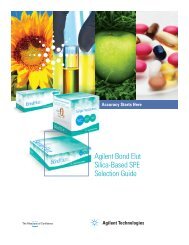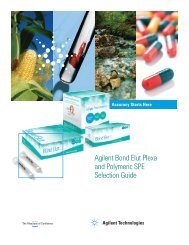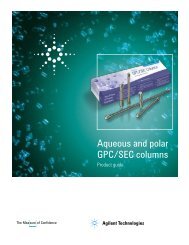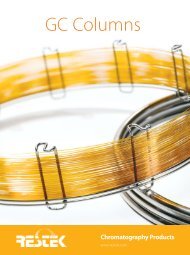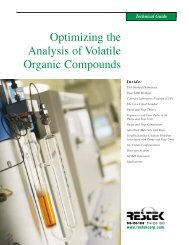Rxi ® -624Sil MS (PDF)
Rxi ® -624Sil MS (PDF)
Rxi ® -624Sil MS (PDF)
You also want an ePaper? Increase the reach of your titles
YUMPU automatically turns print PDFs into web optimized ePapers that Google loves.
RESTEK PHARMA<br />
Chromatography Products<br />
innovative pharmaceutical solutions<br />
<strong>Rxi</strong><strong>®</strong>-<strong>624Sil</strong> <strong>MS</strong><br />
The "Go To" GC Column for Fast,<br />
Effective Volatile Impurities<br />
Method Development<br />
Visit us at www.restek.com/pharma<br />
www.restek.com • 800-356-1688 • 814-353-1300
2<br />
Accelerate Development<br />
In drug development, time-to-market is everything, but finding the right column can be laborious and<br />
time-consuming. Commonly, “624” (6% cyanopropyl phenyl/94% dimethyl polysiloxane) type columns<br />
are used for GC/FID impurity analyses to provide the necessary selectivity, but when mass spectrometry<br />
is needed, method development often starts with lower bleed “1” (100% dimethyl polysiloxane) and “5"<br />
(5% diphenyl/95% dimethyl polysiloxane) type columns. Now, you can get to market faster and more<br />
efficiently by using a single column that combines these attributes—the new <strong>Rxi</strong><strong>®</strong>-<strong>624Sil</strong> <strong>MS</strong> column.<br />
With enhanced retention and selectivity of polar compounds, compatibility with mass spec detectors, and<br />
unsurpassed inertness, <strong>Rxi</strong><strong>®</strong>-<strong>624Sil</strong> <strong>MS</strong> columns are the most broadly applicable GC columns available to<br />
the pharmaceutical industry. Speed up successful method development by making <strong>Rxi</strong><strong>®</strong>-<strong>624Sil</strong> <strong>MS</strong><br />
columns your “go to” column of choice for polar impurities.<br />
Go To…the right column first<br />
For better retention of polar analytes and improved accuracy, peak shape,<br />
and response for active compounds.<br />
Go To…mass spec directly<br />
With the lowest bleed 624 column available; stable up to 320 °C, for easy transfer of methods to GC/<strong>MS</strong>.<br />
Go To…the next batch faster<br />
With the best-in-class G43 for USP methods.<br />
How did we create the <strong>Rxi</strong> Column Family?<br />
We’ve optimized phase chemistry, column deactivation, and our manufacturing process to ensure<br />
the comprehensive performance that makes <strong>Rxi</strong><strong>®</strong>-<strong>624Sil</strong> <strong>MS</strong> columns the best starting point for<br />
method development.<br />
Fused Silica<br />
Polyimide<br />
visit www.restek.com/pharma<br />
<strong>Rxi</strong><strong>®</strong>-<strong>624Sil</strong> <strong>MS</strong><br />
The Go To GC Column for Fast, Effective Volatile<br />
Impurities Method Development<br />
<strong>Rxi</strong> Deactivation<br />
Effectively shields reactive silanols<br />
Ensures comprehensive inertness<br />
(acids and bases)<br />
Provides symmetric peaks<br />
<strong>Rxi</strong> Phase Chemistry<br />
Enhances selectivity<br />
Increases thermal stability<br />
Lowers bleed for <strong>MS</strong> compatibility<br />
Surface bonding increases durability<br />
<strong>Rxi</strong> Manufacturing<br />
Tighter quality controls for better<br />
performance and column-to-column<br />
reproducibility
Go To...the Right Column First<br />
Balanced Retention Simplifies Method Development For Polar Impurities<br />
While “1s and 5s” are often used initially in GC/<strong>MS</strong> method development because of their thermal stability, their nonpolar character<br />
results in poor retention for polar compounds and costs additional development time. In contrast, midpolarity <strong>Rxi</strong><strong>®</strong>-<strong>624Sil</strong> <strong>MS</strong><br />
columns provide improved retention and selectivity for polar compounds and are also more compatible with polar injection solvents.<br />
Highly volatile, polar alkyl halide genotoxic impurities, for example, are difficult to retain on 1s and 5s, but the <strong>Rxi</strong><strong>®</strong>-<strong>624Sil</strong><br />
<strong>MS</strong> column provides higher retention capacity, making GC/<strong>MS</strong> analysis easier to control and allowing faster method development<br />
(Figure 1).<br />
Figure 1 Polar compounds, such as alkyl halides, are highly retained on midpolarity <strong>Rxi</strong><strong>®</strong>-<strong>624Sil</strong> <strong>MS</strong> columns, making<br />
method development faster and easier than on a nonpolar 1 or 5 type column.<br />
Enhanced retention for hard-to-retain polar<br />
analytes makes method development easier!<br />
GC_PH1166<br />
Peaks RT (min.)<br />
1. 2-Chloropropane 2.10<br />
2. Bromoethane 2.36<br />
3. 1-Chloropropane 2.72<br />
4. 2-Bromopropane 3.393<br />
5. Butyl chloride 4.627<br />
6. 1-Bromobutane 5.973<br />
Column <strong>Rxi</strong> <strong>®</strong> -<strong>624Sil</strong> <strong>MS</strong>, 20 m, 0.18 mm ID, 1.00 µm (cat.# 13865)<br />
Sample<br />
Diluent: D<strong>MS</strong>O<br />
Conc.: 1 µg/mL each compound<br />
Injection<br />
Inj. Vol.: 1 µL splitless (hold 0.5 min.)<br />
Liner: 3.5mm Single Gooseneck Liner with wool placed 3cm<br />
from top (middle) (cat.# 22286)<br />
Inj. Temp.: 220 °C<br />
Purge Flow: 3 mL/min.<br />
Oven<br />
Oven Temp: 40 °C (hold 3 min.) to 200 °C at 20 °C/min.<br />
Carrier Gas He, constant flow<br />
Linear Velocity: 40 cm/sec.<br />
Detector <strong>MS</strong><br />
Mode: Scan<br />
Transfer Line Temp.: 280 °C<br />
Analyzer Type: Quadrupole<br />
Source Temp.: 280 °C<br />
Solvent Delay Time: 0.5 min.<br />
Ionization Mode: EI<br />
Scan Range: 30-300 amu<br />
Scan Rate: 5 scans/sec.<br />
Instrument Shimadzu 2010 GC & QP2010+ <strong>MS</strong><br />
Notes: EIC of 42, 43, 57, 108 m/z<br />
Visit www.restek.com/rxi for<br />
detailed comparisons and to learn<br />
how exceptional <strong>Rxi</strong><strong>®</strong> inertness,<br />
bleed, and reproducibility can<br />
improve your data.<br />
The versatility of an <strong>Rxi</strong><strong>®</strong>-<strong>624Sil</strong> <strong>MS</strong><br />
column makes it a perfect fit for<br />
Quality By Design.<br />
visit www.restek.com/pharma<br />
3
4<br />
Go To...the Right Column First<br />
Balanced Inertness Gives Higher Data Quality—<br />
Excellent Peak Symmetry and Reproducibility for Active Compounds<br />
In addition to offering better retention of polar analytes, <strong>Rxi</strong><strong>®</strong>-<strong>624Sil</strong> <strong>MS</strong> columns are exceptionally inert, reducing the need to switch<br />
columns when developing methods for active compounds, such as amines. Amines are commonly found on pharmaceutical impurities<br />
and can interact with surface silanols resulting in a tailing peak. Proper deactivation is the best way to combat this, and <strong>Rxi</strong><strong>®</strong><br />
technology provides the most balanced deactivation, assuring good peak symmetry for both basic and acidic compounds. Columns<br />
that are not effectively deactivated for basic compounds produce unacceptable peak tailing (Figure 2). In contrast, the <strong>Rxi</strong><strong>®</strong>-<strong>624Sil</strong><br />
<strong>MS</strong> column provides excellent peak shape, which leads to consistent peak integration, improved linearity, and higher method sensitivity<br />
(Figure 3).<br />
Figure 2 Innovative <strong>Rxi</strong><strong>®</strong> deactivation technology provides excellent peak symmetry at 5 ng on-column for primary,<br />
secondary, and tertiary amines, which is not possible on competitive columns.<br />
<strong>Rxi</strong> <strong>®</strong> -<strong>624Sil</strong> <strong>MS</strong><br />
DB-624<br />
ZB-624<br />
GC_PH1162<br />
Figure 3 Primary amines, such as isopropylamine, can be more accurately integrated on an <strong>Rxi</strong><strong>®</strong>-<strong>624Sil</strong> <strong>MS</strong> column,<br />
lowering levels of quantification (LOQs) and increasing method accuracy.<br />
<strong>Rxi</strong><strong>®</strong>-<strong>624Sil</strong> <strong>MS</strong><br />
5-100 ng on-column,<br />
R 2 = 0.99996<br />
GC_PH1163<br />
Exceptional peak symmetry<br />
and retention time stability<br />
result in high sensitivity and<br />
linearity on the <strong>Rxi</strong>-<strong>624Sil</strong> <strong>MS</strong><br />
Same conditions as figure 2.<br />
visit www.restek.com/pharma<br />
Highly inert <strong>Rxi</strong><strong>®</strong>-<strong>624Sil</strong> <strong>MS</strong> columns<br />
give excellent peak symmetry.<br />
Peaks Conc.<br />
(µg/mL)<br />
1. Isopropylamine 100<br />
2. Diethylamine 100<br />
3. Triethylamine 100<br />
Column 30 m, 0.32 mm ID, 1.8 µm (cat.# 13870)<br />
Sample Isopropylamine<br />
Diluent: D<strong>MS</strong>O<br />
Conc.: 100 µg/mL<br />
Injection<br />
Inj. Vol.: 1 µL split (split ratio 20:1)<br />
Liner: 5mm Single Gooseneck with Wool (cat.# 22973-200.1)<br />
Inj. Temp.: 250 °C<br />
Oven<br />
Oven Temp: 50 °C (hold 1 min.) to 200 °C at 20 °C/min. (hold 5 min.)<br />
Carrier Gas He, constant flow<br />
Linear Velocity: 37 cm/sec.<br />
Detector FID @ 250 °C<br />
Instrument Agilent/HP6890 GC<br />
ZB-624<br />
Integration not possible<br />
below 25 ng<br />
GC_PH1164
Go To...the Right Column First<br />
Other active compounds, such as glycols, also exhibit peak tailing as a result of reactivity with the chromatographic<br />
system. For example, when analyzing ethylene glycol and diethylene glycol in glycerin<br />
according to a new FDA Guidance for Industry, only the <strong>Rxi</strong><strong>®</strong>-<strong>624Sil</strong> <strong>MS</strong> column gives the selectivity and<br />
peak symmetry needed for these reactive compounds (Figure 4). Satisfy this and other industry guidances<br />
quickly, by choosing the right column, the first time.<br />
Figure 4 <strong>Rxi</strong><strong>®</strong>-<strong>624Sil</strong> <strong>MS</strong> columns provide the best overall inertness and selectivity for<br />
ethylene glycol and diethylene glycol impurities in glycerin, glycol, or sorbitol solutions.<br />
Best in Class—<strong>Rxi</strong><strong>®</strong>-<strong>624Sil</strong> <strong>MS</strong><br />
USP tailing<br />
(ethylene glycol)<br />
Resolution<br />
(ethylene glycol/<br />
propylene glycol)<br />
<strong>Rxi</strong> <strong>®</strong> -<strong>624Sil</strong> <strong>MS</strong> ZB-624 DB-624<br />
1.8 2.7 1.8<br />
9.7 8.4 7.2<br />
<strong>Rxi</strong><strong>®</strong>-<strong>624Sil</strong> <strong>MS</strong><br />
GC_PH1151<br />
Column 30 m, 0.32 mm ID, 1.80 µm (cat.# 13870)<br />
Sample<br />
Diluent: methanol<br />
Injection<br />
Inj. Vol.: 1 µL split (split ratio 10:1)<br />
Liner: 5mm Single Gooseneck with Wool (cat.# 22973-200.1)<br />
Inj. Temp.: 220 °C<br />
Oven<br />
Oven Temp: 100 °C (hold 4 min.) to 120 °C at 50 °C/min. (hold 10 min.)<br />
to 220 °C at 50 °C/min. (hold 6 min.)<br />
Carrier Gas He, constant flow<br />
Linear Velocity: 40 cm/sec.<br />
Detector FID @ 250 °C<br />
Instrument Agilent/HP6890 GC<br />
Notes Columns tested: <strong>Rxi</strong> <strong>®</strong> -<strong>624Sil</strong> <strong>MS</strong>, ZB-624, and DB-624<br />
ZB-624 Column DB-624 Column<br />
Peaks RT (min.) Conc.<br />
(mg/mL)<br />
Ethylene glycol 3.757 0.05<br />
Propylene glycol 4.422 2.0<br />
2,2,2-Trichloroethanol (IS) 7.461 0.1<br />
Diethylene glycol 10.416 0.05<br />
visit www.restek.com/pharma<br />
Innovation & Service<br />
"Having a background in<br />
LC/<strong>MS</strong>/<strong>MS</strong> does not automatically<br />
qualify one to run GC/<strong>MS</strong>.<br />
Julie Kowalski spent time with<br />
me to help me decide which<br />
column would be the best for<br />
my application as well as which<br />
consumables I would need to<br />
do routine maintenance. The<br />
time and knowledge she shared<br />
with me saved me multiple<br />
headaches and will keep me a<br />
loyal Restek customer!"<br />
Richard, Biologist<br />
National Institute of Health<br />
How can we help you today?<br />
Contact support@restek.com or<br />
your local Restek representative<br />
for helpful, knowledgeable<br />
technical support.<br />
Couple the right column<br />
with the right liner. Visit<br />
www.restek.com/liners<br />
for a complete<br />
selection.<br />
5
6<br />
Go To...Mass Spec Directly<br />
High Thermal Stability and Low Bleed for GC/<strong>MS</strong> Compatibility<br />
While midpolarity 624 type columns offer better retention of polar analytes than 1s and 5s, most 624s have low thermal stability and<br />
generate too much column bleed to be useful for mass spec work. However, the <strong>Rxi</strong><strong>®</strong>-<strong>624Sil</strong> <strong>MS</strong> column is fully compatible with mass<br />
spectrometry, due to stabilizing technology that delivers the highest thermal stability and lowest bleed of any polar capillary column<br />
in its class (Table I, Figure 5). Eliminate the need to change columns when mass spec is required—unlike other 624 columns, <strong>Rxi</strong><strong>®</strong>-<br />
<strong>624Sil</strong> <strong>MS</strong> columns take your method directly to GC/<strong>MS</strong>. Keep the same 624 retention and selectivity, but leave the bleed behind.<br />
Table I The <strong>Rxi</strong><strong>®</strong>-<strong>624Sil</strong> <strong>MS</strong> column has the highest thermal stability of any 624 column.<br />
Column Manufacturer Highest Temperature Limit (Isothermal)<br />
<strong>Rxi</strong> <strong>®</strong> -<strong>624Sil</strong> <strong>MS</strong> Restek 320 °C<br />
VF-624ms Varian 300 °C<br />
DB-624 Agilent J&W 260 °C<br />
ZB-624 Phenomenex 260 °C<br />
Data obtained from company website or literature for a 30 m x 0.25 mm x 1.4 µm df column.<br />
Figure 5 The <strong>Rxi</strong><strong>®</strong>-<strong>624Sil</strong> <strong>MS</strong> column has the lowest bleed of any column in its class, providing true GC/<strong>MS</strong> capability.<br />
GC_GN1147<br />
Column 30 m, 0.25 mm ID, 1.4 µm (cat.# 13868)<br />
Sample Fluorobenzene (cat.# 30030)<br />
Diluent: methanol<br />
Conc.: 200 µg/mL<br />
Injection<br />
Inj. Vol.: 1 µL split (split ratio 20:1)<br />
Liner: 4mm Split Liner with Wool (cat.# 20781)<br />
Inj. Temp.: 220 °C<br />
Oven<br />
Oven Temp: 40 °C (hold 5 min.) to 60 °C at 20 °C/min. (hold 5 min.) to 120 °C at 20 °C/min. (hold 5 min.)<br />
to 200 °C at 20 °C/min. (hold 10 min.) to 260 °C at 20 °C/min. (hold 10 min.) to 300 °C at 20 °C/min. (hold 20 min.)<br />
Carrier Gas He, constant flow<br />
Linear Velocity: 40 cm/sec.<br />
Detector FID @ 250 °C<br />
Instrument Agilent/HP6890 GC<br />
Notes Columns are of equivalent dimensions and were tested after equivalent conditioning.<br />
visit www.restek.com/pharma<br />
Ideal for use<br />
with FID and <strong>MS</strong><br />
detectors.<br />
High thermal stability <strong>Rxi</strong><strong>®</strong>-<strong>624Sil</strong> <strong>MS</strong> columns offer:<br />
• Longer column lifetime.<br />
• Improved method reproducibility.<br />
• GC/<strong>MS</strong> compatibility.<br />
• Stable baseline.
Go To...Mass Spec Directly<br />
Selective, Retentive, and Compatible with Polar Injection Solvents<br />
The <strong>Rxi</strong><strong>®</strong>-<strong>624Sil</strong> <strong>MS</strong> column combines the thermal stability of a mass spec friendly column with the selectivity, retention, and injection<br />
solvent compatibility needed to analyze polar impurities. For example, when analyzing mesylate, besylate, and tosylate genotoxic<br />
impurities by GC/<strong>MS</strong>, the <strong>Rxi</strong><strong>®</strong>-<strong>624Sil</strong> <strong>MS</strong> column provides excellent selectivity, stability, and sensitivity (Figure 6). The innovative<br />
stationary phase is compatible with a variety of injection solvents, allowing splitless injection techniques to be used for heightened<br />
sensitivity. Bleed-free thermal stability allows oven “bake-out” programs to be used for contaminant removal and longer column lifetimes.<br />
Figure 6 The <strong>Rxi</strong><strong>®</strong>-<strong>624Sil</strong> <strong>MS</strong> phase is more compatible with polar injection solvents than 1 or 5 type columns,<br />
providing higher sensitivity and less time needed for optimizing injection parameters.<br />
Excellent symmetry for<br />
M<strong>MS</strong> and iP<strong>MS</strong> show<br />
compatibility with<br />
polar injection solvents<br />
and splitless injection.<br />
Column <strong>Rxi</strong> <strong>®</strong> -<strong>624Sil</strong> <strong>MS</strong>, 20 m, 0.18 mm ID, 1.00 µm (cat.# 13865)<br />
Sample<br />
Diluent: 90:10 acetonitrile:water<br />
Conc.: 500 ng/mL<br />
Injection<br />
Inj. Vol.: 1 µL splitless (hold 0.5 min.)<br />
Liner: 3.5mm Single Gooseneck Liner with wool placed 3cm from top<br />
(middle) (cat.# 22286)<br />
Inj. Temp.: 220 °C<br />
Purge Flow: 3 mL/min.<br />
Oven<br />
Oven Temp: 80 °C (hold 2 min.) to 300 °C at 20 °C/min. (hold 5 min.)<br />
Carrier Gas He, constant flow<br />
Linear Velocity: 45 cm/sec.<br />
GC_PH1165<br />
Peaks RT (min.) Ions Monitored<br />
(m/z)<br />
1. Methyl methanesulfonate (M<strong>MS</strong>) 4.253 79, 80, 95<br />
2. Isopropyl methanesulfonate (iP<strong>MS</strong>) 5.043 59, 79, 123<br />
3. Diethyl sulfate (DES) 6.010 111, 125, 139<br />
4. di-isopropyl sulfate (DPS) 6.357 45, 87, 167<br />
5. dibutyl sulfate (DBS) 9.260 29, 41, 56<br />
6. Methyl benzenesulfonate (MBS) 9.463 77, 141, 172<br />
7. Ethyl benzenesulfonate (EBS) 9.883 77, 141, 186<br />
8. Methyl toluenesulfonate (MTS) 10.337 91, 155, 186<br />
9. Ethyl toluenesulfonate (ETS) 10.713 91, 155, 200<br />
10. n-propyl toluenesulfonate (nPTS) 10.827 91, 155, 172<br />
11. n-butyl benzenesulfonate (nBBS) 11.07 77, 141, 159<br />
12. isopropyl p-toluenesulfonate (iPTS) 11.240 91, 155, 172<br />
13. p-toluenesulfonic acid n-butyl ester (nBTS) 11.823 91, 155, 173<br />
* Ortho isomers of ETS.<br />
Low bleed at 300°C allows for “bake-out”<br />
oven programs.<br />
Fast GC<br />
Analysis<br />
Detector <strong>MS</strong><br />
Mode: SIM<br />
Transfer Line<br />
Temp.: 280 °C<br />
Analyzer Type: Quadrupole<br />
Source Temp.: 280 °C<br />
Solvent Delay<br />
Time: 4 min.<br />
Ionization<br />
Mode: EI<br />
Instrument Shimadzu 2010 GC & QP2010+ <strong>MS</strong><br />
Acknowledgement In collaboration with Merck and Company<br />
Restek carries a full line of innovative GC/<strong>MS</strong> accessories built to make<br />
your life easier.<br />
Visit www.restek.com for a complete selection.<br />
visit www.restek.com/pharma<br />
7
8<br />
Go To...the Next Batch Faster<br />
Improve Pass Rates with the Best-In-Class G43 for USP <br />
System suitability is a major factor in overall lab productivity, and <strong>Rxi</strong><strong>®</strong>-<strong>624Sil</strong> <strong>MS</strong> columns provide the optimized selectivity and<br />
guaranteed reproducibility needed to increase pass rates. For example, batch throughput can be improved for USP residual<br />
solvents analysis by using a column that provides increased resolution and sensitivity for system suitability components (Figures 7<br />
and 8). Benefits include industry-leading resolution of acetonitrile and dichloromethane, as well as benzene and 1,2-dichloroethane.<br />
No other 624 type column performs as well as <strong>Rxi</strong><strong>®</strong>-<strong>624Sil</strong> <strong>MS</strong> columns for these critical system suitability requirements.<br />
Figure 7 Improve system suitability pass rates—the innovative polymer chemistry of the <strong>Rxi</strong><strong>®</strong>-<strong>624Sil</strong> <strong>MS</strong> column<br />
provides greater resolution of critical pairs.<br />
Peaks RT (min.) Conc.<br />
(µg/mL)<br />
1. 1,1-Dichloroethene 3.586 0.07<br />
2. 1,1,1-Trichloroethane 8.536 0.08<br />
3. Carbon tetrachloride 9.042 0.03<br />
4. Benzene 9.787 0.02<br />
5. 1,2-Dichloroethane 10.112 0.04<br />
* D<strong>MS</strong>O interference<br />
Columns were tested under identical operating conditions and after identical conditioning.<br />
For the complete application and<br />
technical tips on USP, visit<br />
www.restek.com/usp467.<br />
<strong>Rxi</strong><strong>®</strong>-<strong>624Sil</strong> <strong>MS</strong><br />
• Baseline resolution<br />
• Easy, reliable quantification<br />
GC_PH1160<br />
Column <strong>Rxi</strong> <strong>®</strong> -<strong>624Sil</strong> <strong>MS</strong>, 30 m, 0.32 mm ID,<br />
1.80 µm (cat.# 13870)<br />
Sample Residual Solvents - Class 1 (cat.# 36279)<br />
Diluent: water<br />
Injection headspace-loop split (split ratio 5:1)<br />
Liner: 1mm Split (cat.# 20972)<br />
Headspace-Loop<br />
Inj. Port Temp.: 140 °C<br />
Instrument: Tekmar HT3<br />
Inj. Time: 1 min.<br />
Transfer Line Temp.: 110 °C<br />
Valve Oven Temp.: 110 °C<br />
Sample Temp.: 80 °C<br />
Sample Equil. Time: 60 min.<br />
Vial Pressure: 10 psi<br />
Pressurize Time: 0.5 min.<br />
visit www.restek.com/pharma<br />
DB-624<br />
Class 1 solvents coelute<br />
Pressure<br />
Equilibration Time: 0.05 min.<br />
Loop Pressure: 5 psi<br />
Loop Fill Time: 0.1 min.<br />
Oven<br />
Oven Temp: 40 °C (hold 20 min.) to 240 °C at 10 °C/min.<br />
(hold 20 min.)<br />
Carrier Gas He, constant flow<br />
Linear Velocity: 35 cm/sec.<br />
Dead Time: 1.45 min. @ 40 °C<br />
Detector FID @ 250 °C<br />
Data Rate: 5 Hz<br />
Instrument Agilent/HP6890 GC<br />
Acknowledgement Teledyne Tekmar<br />
Custom Residual<br />
Solvent Mixes<br />
A perfect match for validated residual<br />
solvent methods<br />
Save time and money with mixes prepared to<br />
your specific solvent set and concentrations. The<br />
more you buy the less you pay per ampule!<br />
Easy Online Order Form!<br />
www.restek.com/customusp
Go To...the Next Batch Faster<br />
Figure 8 The <strong>Rxi</strong><strong>®</strong>-<strong>624Sil</strong> <strong>MS</strong> column provides best-in-class system suitability performance for the USP Class 2<br />
Mixture A solution.<br />
<strong>Rxi</strong><strong>®</strong>-<strong>624Sil</strong> <strong>MS</strong><br />
Best in class G43<br />
ZB-624<br />
Improve system suitability<br />
pass rates with greater resolution<br />
on <strong>Rxi</strong><strong>®</strong>-<strong>624Sil</strong> <strong>MS</strong> columns.<br />
Peaks RT (min.) Conc.<br />
(µg/mL)<br />
1. Methanol 2.281 25.00<br />
2. Acetonitrile 4.009 3.42<br />
3. Dichloromethane 4.313 5.00<br />
4. trans-1,2-Dichloroethene 4.798 7.83<br />
5. cis-1,2-Dichloroethene 7.028 7.83<br />
6. Tetrahydrofuran 7.706 5.75<br />
7. Cyclohexane 8.708 32.33<br />
Columns were tested under identical operating conditions and after identical conditioning. See Figure 7 for conditions.<br />
Screw-Thread Headspace Vials (18mm)<br />
Hot Swap Capillary Column Nuts<br />
GC_PH1161<br />
Quickly change columns for USP Procedures A and B using a Hot Swap Capillary Column Nut!<br />
Description qty. cat.# price<br />
For use with “compact” Agilent-style ferrules.<br />
Hot Swap Capillary Column Nut ea. 22348 enquire<br />
For use with standard 1 /16"-type ferrules.<br />
Hot Swap Capillary Column Nut ea. 22347 enquire<br />
NOTE: For proper operation, oven fan must be kept operational during change out or risk of burn may occur.<br />
8. Methylcyclohexane 14.099 9.83<br />
9. 1,4-Dioxane 15.054 3.17<br />
10. Toluene 22.018 7.42<br />
11. Chlorobenzene 26.570 3.00<br />
12. Ethylbenzene 26.837 3.07<br />
13. m-Xylene 27.147 10.85<br />
14. p-Xylene 27.147 2.53<br />
15. o-Xylene 27.927 1.63<br />
Description Volume Color Dimensions 100-pk. 1000-pk.<br />
Headspace Vial 10mL Clear 22 x 45mm 23084 enquire 23085 enquire<br />
Headspace Vial 10mL Amber 22 x 45mm 23088 enquire 23089 enquire<br />
Headspace Vial 20mL Clear 22 x 75mm 23082 enquire 23085 enquire<br />
Headspace Vial<br />
Caps not included.<br />
20mL Amber 22 x 75mm 23086 enquire 23089 enquire<br />
Magnetic Screw-Thread Caps (18mm)<br />
Description Septa Material 100-pk. 1000-pk.<br />
Magnetic Caps and Septa PTFE/Silicone 23090 enquire 23091 enquire<br />
Magnetic Caps and Septa PTFE/Silicone for SPME 23092 enquire 23093 enquire<br />
Magnetic Caps and Septa PTFE/Red Chlorobutyl 23094 enquire 23095 enquire<br />
visit www.restek.com/pharma<br />
9
10<br />
Go To...the Next Batch Faster<br />
Guaranteed Reliable Column-to-Column Performance<br />
Reliable column-to-column performance also contributes to lab productivity as less column variation means faster setup and more<br />
consistent results. <strong>Rxi</strong><strong>®</strong> column technology has enabled Restek to tighten our quality control standards and guarantee consistency.<br />
Columns from multiple manufacturing batches show the excellent reproducibility obtained using the new <strong>Rxi</strong><strong>®</strong> manufacturing<br />
process (Figure 9). All <strong>Rxi</strong><strong>®</strong> columns are individually tested to assure performance.<br />
Figure 9 Three manufacturing batches of <strong>Rxi</strong><strong>®</strong> columns show excellent reproducibility.<br />
1<br />
2<br />
3<br />
4<br />
5<br />
GC_EV00819<br />
Column: <strong>Rxi</strong> <strong>®</strong> -5ms, 30m, 0.25mm ID, 0.25µm (cat.# 13423)<br />
Sample: 500µg/mL Isothermal Column Test Mix in toluene<br />
Inj.: 1.0µL, split injection (split ratio 1:100), 4mm single gooseneck inlet liner<br />
with wool (cat.# 22405)<br />
Inj. temp.: 250°C<br />
Carrier gas: hydrogen, constant flow<br />
Linear velocity: 38cm/sec. @ 135°C<br />
Oven temp.: 135°C<br />
Det.: FID @ 330°C<br />
6 7 8<br />
1. 1,6-hexanediol<br />
2. 4-chlorophenol<br />
3. methyl nonanoate<br />
4. 1-decylamine<br />
5. tridecane<br />
6. 1-undecanol<br />
7. acenaphthylene<br />
8. pentadecane<br />
Column 722883<br />
Batch #1<br />
Column 717989<br />
Batch #2<br />
Column 720331<br />
Batch #3<br />
Go To…<strong>Rxi</strong><strong>®</strong>-<strong>624Sil</strong> <strong>MS</strong> Columns for Faster Method Development<br />
Optimized phase chemistry, column deactivation, and manufacturing make <strong>Rxi</strong><strong>®</strong>-<strong>624Sil</strong> <strong>MS</strong> columns the “go to” column for pharmaceutical<br />
method development. With better retention of polar compounds than 1 and 5 type columns, lower bleed than any other<br />
624 column, and unsurpassed inertness, <strong>Rxi</strong><strong>®</strong>-<strong>624Sil</strong> <strong>MS</strong> columns offer the most comprehensive performance, allowing you to develop<br />
successful methods quickly, easily, and reliably. Try one for your next method today.<br />
Innovation & Service<br />
"When my research group needed a GC column for a chiral separation,<br />
Restek was the only company that offered to provide us with test columns<br />
to evaluate. The willingness of Restek to work with us to find a solution to<br />
our separation problem is exceptional."<br />
Joe Dinnocenzo,<br />
Professor of Chemistry<br />
Director, Center for Photoinduced Charge Transfer<br />
University of Rochester<br />
How can we help you today?<br />
Contact support@restek.com or your local Restek representative for helpful,<br />
knowledgeable technical support.<br />
visit www.restek.com/pharma<br />
Technical<br />
Opportunities<br />
Expand your knowledge and improve<br />
your results with Restek.<br />
• Download our free technical literature.<br />
• View free technical webinars.<br />
• Contact us for on-site GC training.
Compare and Save<br />
Restek Offers an Exclusive Line of Innovative and Cost-Effective GC Products<br />
<strong>Rxi</strong><strong>®</strong>-<strong>624Sil</strong> <strong>MS</strong> Columns (fused silica)<br />
(mid polarity Crossbond<strong>®</strong> silarylene phase; equivalent to 6% cyanopropylphenyl/94% dimethyl polysiloxane)<br />
Low bleed, high thermal stability column—maximum temperatures up to 320 °C.<br />
Inert—excellent peak shape for a wide range of compounds, including acidic and basic compounds.<br />
Selective—highly selective for residual solvents, great choice for USP.<br />
Manufactured for column-to-column reproducibility—well-suited for validated methods.<br />
ID df (µm) temp. limits 20-Meter 30-Meter 60-Meter<br />
0.18mm 1.00 -20 to 300/320°C 13865 enquire<br />
0.25mm 1.40 -20 to 300/320°C 13868 enquire<br />
0.32mm 1.80 -20 to 300/320°C 13870 enquire 13872 enquire<br />
0.53mm 3.00 -20 to 280/300°C 13871 enquire<br />
Restek Electronic Leak Detector<br />
Why have a small leak turn into a costly repair? Protect your data and analytical column by using a Restek<br />
Leak Detector.<br />
Description qty. cat.# price<br />
Leak Detector with Hard-Sided Carrying Case and Universal Charger Set (US, UK, European, Australian) ea. 22839 enquire<br />
Soft-Side Storage Case ea. 22657 enquire<br />
Small Probe Adaptor<br />
Avoid using liquid leak detectors on a GC! Liquids can be drawn into the system.<br />
ea. 22658 enquire<br />
GC/<strong>MS</strong> Cleaning Kit<br />
Description qty. cat.# price<br />
Mass Spec Cleaning Kit with Dremel Tool kit 27194 enquire<br />
Mass Spec Cleaning Kit without Dremel Tool kit 27195 enquire<br />
Mass Spec Cleaning Kit Replacement Parts Kit<br />
(includes cloths, micro mesh sheets, small and large gloves) kit 27196 enquire<br />
ETP Electron Multipliers<br />
for Mass Spectrometry<br />
Air stable.<br />
2-year shelf life guarantee.<br />
Discrete dynode design results in extended operating life.<br />
Description qty. cat.# price<br />
Electron Multipliers for Agilent GC/<strong>MS</strong> and LC/<strong>MS</strong><br />
For Agilent 5970 GC/<strong>MS</strong> ea. 23072 enquire<br />
For Agilent 5971, 5972, GC GC/<strong>MS</strong> ea. 23073 enquire<br />
For Agilent 5973 & 5975 GC/<strong>MS</strong> (includes mount for initial installation)*† ea. 23074 enquire<br />
For Agilent 5973 & 5975 GC/<strong>MS</strong> and LC/<strong>MS</strong>D (Replacement Multiplier)*† ea. 23075 enquire<br />
For Agilent LC/<strong>MS</strong>D (includes mount for initial installation)*† ea. 23076 enquire<br />
Electron Multiplier for Applied Biosystems (Sciex)<br />
For API 300, 3000 & 4000 Applied Biosystems ea. 23077 enquire<br />
Electron Multiplier for Thermo Finnigan GC/<strong>MS</strong><br />
For Thermo TRACE DSQ, DSQII, and Polaris-Q GC/<strong>MS</strong> ea. 23081 enquire<br />
*First time installation requires a mount which includes the mechanical housing. After initial installation, only the replacement<br />
electron multiplier is required.<br />
†This unit is designed for use in the 5975, 5973 GC and the LC/<strong>MS</strong>D.<br />
In Stock Now!<br />
USP-equivalent residual solvent<br />
Class 1 & 2 mixes & singles.<br />
Visit www.restek.com/usp467<br />
for a complete selection<br />
Super Septa<br />
Visit www.restek.com/septa<br />
for a complete selection<br />
visit www.restek.com/pharma<br />
11
PATENTS & TRADEMARKS<br />
Restek patents and trademarks<br />
are the property of Restek<br />
Corporation. Other trademarks<br />
appearing in Restek literature<br />
or on its website are the property<br />
of their respective owners.<br />
Go To Restek for Custom<br />
Residual Solvent Methods<br />
Develop Residual Solvent Methods Faster by “Outsourcing” to<br />
Restek’s Technical Support Team<br />
Speed up residual solvent method development by letting Restek do the work for you.<br />
We have benchmarked ICH Class 1, 2, and 3 residual solvents on our most popular<br />
columns and will model your specific separations with our Pro ezGC software.<br />
We can get you started quickly and accurately with an optimized set<br />
of analytical conditions.<br />
• Fast, effective method development with highly accurate results.<br />
• Customized to your specific solvent list.<br />
• Includes recommended column format and analytical conditions.<br />
Contact Restek’s Technical Support<br />
group at support@restek.com and<br />
let us do the work for you!<br />
Lit. Cat.# PHFL1245<br />
© 2010 Restek Corporation.<br />
Restek U.S. • 110 Benner Circle • Bellefonte, PA 16823 • 814-353-1300 • 800-356-1688 • fax: 814-353-1309 • www.restek.com<br />
Restek France • phone: +33 (0)1 60 78 32 10 • fax: +33 (0)1 60 78 70 90 • e-mail: restek@restekfrance.fr<br />
Restek GmbH • phone: +49 (0)6172 2797 0 • fax: +49 (0)6172 2797 77 • e-mail: info@restekgmbh.de<br />
Restek Ireland • phone: +44 (0)2890 814576 • fax: +44 (0)2890 814576 • e-mail: restekeurope@aol.com<br />
Restek Japan • phone: +81 (3)6459 0025 • fax: +81 (3)6459 0025 • e-mail: ryosei.kanaguchi@restek.com<br />
Thames Restek U.K. LTD • phone: +44 (0)1494 563377 • fax: +44 (0)1494 564990 • e-mail: sales@thamesrestek.co.uk





